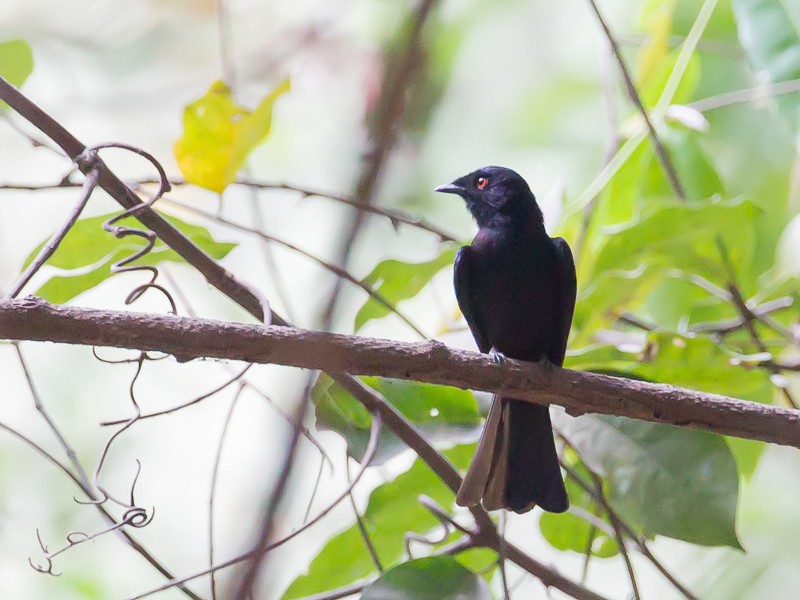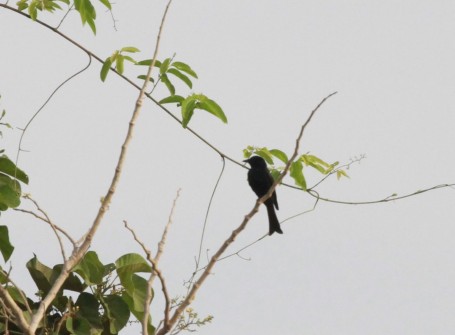Description of a new species of Square-tailed Drongo

It’s not every day that a new bird species is described from West Africa, but thanks to some remarkable detective work by Jérôme Fuchs and colleagues, we now know that the “Square-tailed Drongos” occurring in West African forests should be considered a separate species. The researcher from the French National Museum of Natural History and his co-authors from Guinea, Denmark and the US describe what they named Western Square-Tailed Drongo Dicrurus occidentalis in a paper published earlier this year in the journal Zootaxa: Taxonomic revision of the Square-tailed Drongo species complex (Passeriformes: Dicruridae) with description of a new species from western Africa. The full paper is available on ResearchGate and a nice summary is to be found on this site. The abstract is reproduced below.
In summary, Western Square-tailed Drongo is genetically distinct from its “sister species” Sharpe’s Drongo D. sharpei which occurs further east, but cannot be safely identified in the field. The only morphological differences as per current knowledge are bill shape and size: culmen length, bill width and bill height were found to be sufficiently different from Sharpe’s. The authors provide a detailed description of the holotype, a bird collected by Raymond Pujol and Jean Roché on 18 December 1959 in Sérédou in the N’zérékoré region of Guinea. According to the authors, Western Square-tailed Drongo and Sharpe’s Drongo diverged about 1.3 million years ago, resulting in substantial genetic divergence (6.7%).
Here’s one of the only pictures I could find online of what should now be considered D. occidentalis, from La Guingette forest near Bobo-Dioulasso in Burkina. There’s also this one in the Macaulay Library of a bird in the hand from central Nigeria in 1981.
And for comparison purposes, here’s one of D. ludwigii from South Africa:
Western Square-tailed Drongo is known to occur in secondary forest and gallery forest from coastal Guinea to Nigeria, likely as far east as the Niger/Benue River system in Nigeria. It also occurs in Senegal and in nearby Gambia, more precisely in the forests of Basse-Casamance but also in the Dindefelo area where it was recently found. Of note is that the only publicly available sound recording of this taxon is from Dindefelo¹, made by Jean-François Blanc and friends in March 2016 when they found several Square-tailed Drongos on the edge of the Dande plateau (see Blanc et al. 2018. Noteworthy records from Senegal, including the first Freckled Nightjar, ABC Bull. 25 (1), for more details and a photograph of one of the drongos). There are several relevant recordings on Claude Chappuis’s CD set, one from SW Senegal and a few different call types from gallery forests in S Ivory Coast.
More sound recordings are needed to establish the extent of vocal differences between the various taxa within the Square-tailed Drongo “species complex”; it is mentioned in the species account on HBW that there are clear regional differences in vocalisations: in W Africa more muted calls compared with E birds, which have more “ringing” tone – not surprising now that it is clear that these are different species! As is often the case with closely related and morphologically very similar species, the song and calls are often sufficiently different to be useful to safely identify the species. I have some from Mozambique, but now just need to go to Casamance – another good excuse to make it out there¹.
Of course, I was now wondering whether any of the drongos that we saw in February in the Dindefelo forest and along the nearby Gambia river, were Square-tailed rather than Fork-tailed Drongo which is the default species throughout… but at least on the picture below Fork-tailed can be confirmed.
The “new” species also occurs further east, creeping into SW Mali and S Burkina Faso where some decent gallery forest still remains. In this respect, the distribution map in the paper isn’t very accurate and slightly misleading as it doesn’t include these two countries, and the range shown for Senegal is way too large. Hopefully the precise distribution, both in Senegal and elsewhere in West Africa, will be further refined in coming years.
Abstract:
We describe a new species of drongo in the Square-tailed Drongo (Dicrurus ludwigii) complex using a combination of biometric and genetic data. The new species differs from previously described taxa in the Square-tailed Drongo complex by possessing a significantly heavier bill and via substantial genetic divergence (6.7%) from its sister-species D. sharpei. The new species is distributed across the gallery forests of coastal Guinea, extending to the Niger and Benue Rivers of Nigeria. We suspect that this taxon was overlooked by previous avian systematists because they either lacked comparative material from western Africa or because the key diagnostic morphological character (bill characteristics) was not measured. We provide an updated taxonomy of the Square-tailed Drongo species complex.
¹ Update 2.1.19: in mid-January I managed to sneak out to Casamance for a few days, where I obtained several decent recordings of these drongos, now available on xeno-canto. I also managed a couple of decent pictures, one of which can be found here.






































































































































































































Trackbacks / Pingbacks